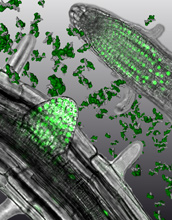All Images
News Release 07-176
Illuminating Study Reveals How Plants Respond to Light
Plants prepare to respond to light while still in the dark
This material is available primarily for archival purposes. Telephone numbers or other contact information may be out of date; please see current contact information at media contacts.

Two proteins known as FHY3 and FAR1 bind to DNA in a plant cell and cause production of two other proteins known as FHY1 and FHL.
When hit with far red light, a light-sensitive protein called phytochrome A (phyA) changes its shape. This shape change allows it to bind to FHY1 and FHL. FHY1 and FHL then carry the activated phyA into the cell nucleus. From there, phyA is able to initiate the plant's developmental responses to light such as growth, flowering and straining towards the light.
Credit: Zina Deretsky, National Science Foundation
Download the high-resolution JPG version of the image. (850 KB)
Use your mouse to right-click (Mac users may need to Ctrl-click) the link above and choose the option that will save the file or target to your computer.

This image shows micrographs of plant roots. The green dots inside indicate presence of the FHY3 protein in the cells' nuclei. Notice the protein has accumulated in the division zone of the primary root.
The artists have added computational models in the middle showing FHY3 protein (in green) binding to DNA (shown in gray).
Researchers have discovered that FHY3 and FAR1, two proteins derived from what are called "jumping genes", put into motion the sequence of events that bring about the light responses of a plant such as growth, flowering and straining towards light.
Credit: Chris Pelkie, Daniel Ripoll, and Rongcheng Lin
Download the high-resolution JPG version of the image. (1.6 MB)
Use your mouse to right-click (Mac users may need to Ctrl-click) the link above and choose the option that will save the file or target to your computer.


